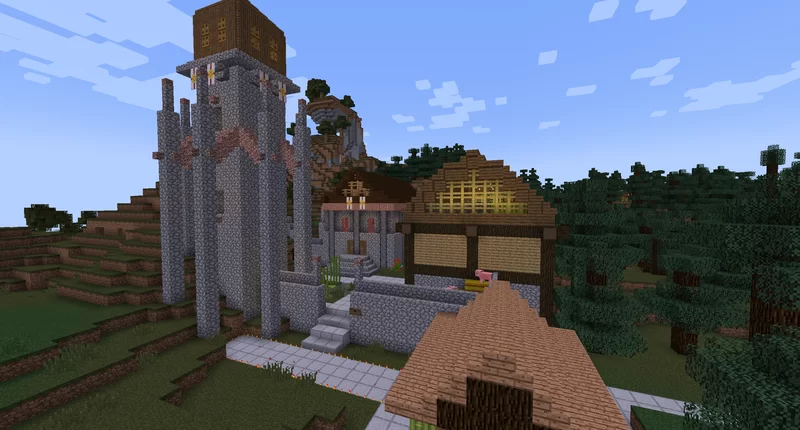Published Jul 11th, 2023, 7/11/23 10:37 am
- 354 views, 2 today
- 9 downloads, 0 today
131
The Talia Donation Monastery is an Innos Monastery in the Kaysangian city of Beita. It is located in the southern part of the city, which is called "Neu Dökkhain (New Dökkhain)" by the residents, although it has no official name. This monastery is a fictional building on the RP world in Gòngguó Digouo (Duchy of Drachenberg) in the Kaysanger Empire. It is mostly built in a medieval German Gothic style, but also has a slight Chinese influence.
Please take a look at my collections; a diamond for these means more to me than for a single project.
See also:
See here for the RP-World
See here for other RP-Worlds’ stand-alone
Age of Empires II - Wonders
Age of Empires II - North-European Building Set
Comments are very welcome!
Das Stiftungskloster Talia ist ein Innos Kloster in der kaysangischen Stadt Beita. Es liegt im südlichen Teil der Stadt, welcher von den Bewohnern „Neu-Dökkhain“ genannt wird, auch wenn er keinen offiziellen Namen hat. Es handelt sich bei diesem Kloster um ein fiktives Gebäude auf der RP-Welt im Gòngguó Digouo (Herzogtum Drachenberg) im Kaysanger Kaiserreich. Es ist überwiegend in einem mittelalterlichen-deutschen gotischen Style erbaut, weist jedoch auch einen leichten chinesischen Einfluss auf.
Aus dem Geschichtsteil des Buches „Beita“ der RP-Welt entnommen:
[…]
Im Jahre 445 auc kam es schließlich zum zweiten norderanisch-ägyptischen Krieg. Der für Nordera absolut verheerende Krieg brachte den Flusshandel vollständig zum erliegen. Weite Teile Südnorderas wurden durch ägyptische Truppe zeitweise besetzt und dabei völlig verwüstet. Besonders die Großjarlstümer Dökkhain und Feuerfeste wurden praktisch völlig zerstört. In Folge dessen kamen viele Flüchtlinge aus Dökkhain über die Grenze. [Gòng] Zhen nahm die Flüchtlinge auf und seine Schwiegertochter Talia [aus dem norderanischen Hause Närchthöltz] übernahm die Verwaltung dieser. Die Stadt Beita wurde dabei in südliche Richtung stark erweitert und um das informell so genannte Stadtviertel „Neu-Dökkhain“ erweitert. Zhen erwog mehrmals einen eigenen Einmarsch nach Dökkhain, jedoch war die militärische Lage zwischen Norderaner und Ägyptern sehr unberechenbar und ein Einmarsch hätte wahrscheinlich beide Seiten aufgestachelt.
Kurz nach dem Ende des Krieges und der norderanischen Reichsauflösung starb auch Zhen. Doch statt nach dem Krieg nach Dökkhain zurück zu kehren verblieben viele Flüchtlinge in Beita und bauten sich hier ihr neues Leben auf – unterstützt durch den neuen Gòng Yating und seiner Frau Talia. Gemeinsam stifteten sie sogar den Bau eines Innos-Klosters in Beita. Es ist das einzige Innos-Kloster außerhalb von Nordera. Es ist damit auch einer der sehr wenigen ausländisch-sakralen Gebäuden im Kaysanger Reich. Nach ihrer Einbürgerung bekamen die ehemaligen Flüchtlinge auch weite Rechte zugesichert; insbesondere den Religionsdispens, welcher es ihnen erlaubte eine nicht Staatsreligion überhaupt aktiv betreiben zu dürfen. Zusammen mit dem Kloster wurden nun auch typische norderanische Handwerker angesiedelt. Besonders Baumeister und Holzarbeiter zogen in die Region, und brachten damit Beita eine einzigartige Mischung aus norderansicher und kaysangischer Baukunst. Das Kloster wiederum brachte Novizen und Feuermagier in die Stadt. Innos-Kloster sind neben religiösen Einrichtungen auch immer Wirtschaftsbetriebe, welche oft auch auf eine Aufgabe spezialisiert werden. Im Falle des Beita-Klosters wurde dies die Heilungsalchemie. Nach dem Tod Talias im Jahre 478 auc wurde das Kloster nach ihr benannt.
Höhe: 29 Blöcke
Tiefe: 4 Blöcke
Breite: 37 Blöcke
Länge: 40 Blöcke
Baustile: Gotik
Funktion: Kloster
Spielversion: 1.20
Speicherformat: 1 .nbt Datei
Bitte werft auch einen Blick auf meine Kollektionen. Ein Diamant für diese bedeutet mir mehr als für ein einzelnes Objekt.
Siehe auch:
Sieh hier für ganze RP-Welt
Sieh hier für andere stand alones der RP-Welt
Age of Empires II - Wonder
Kommentare sind wie immer erwünscht
Bitte werft auch einen Blick auf meine Kollektionen. Ein Diamant für diese bedeutet mir mehr als für ein einzelnes Objekt.
Siehe außerdem:
Age of Empires II - Wunder
Age of Empires II - Architektur Set Nordeuropa
Sieh hier für ganze RP-Welt
Sieh hier für andere stand alones der RP-Welt.
Kommentare sind wie immer erwünscht!
Structural features:
The monastery consists of a walled courtyard surrounded by a hill and three buildings. The buildings are the priory, the church and the bell tower. The priory is multi-storey and includes a library, an alchemy room, a hospital, a writing room, several bedrooms for the monastery staff, and a large dining room with an adjoining open kitchen. All buildings are built in an early Gothic style, although I sometimes deviated from my Chinese-Kaysang style with the roofs and the building materials. In the courtyard of the monastery you will find a pond, which looks clearly East Asian, and a pig pen. There is also access to a burial mound in the courtyard, which has not yet been built.
History (RP World):
Taken from the history part of the book "Beita" of the RP world and translated by Google:
[...]
In 445 auc, the second North Egyptian-Egyptian War broke out. The war, which was absolutely devastating for Nordera, brought river trade to a complete standstill. Large parts of southern Northera were temporarily occupied by Egyptian troops and completely devastated. In particular, the Grand Jarlsdoms of Dökkhain and Firehold were almost completely destroyed. As a result, many refugees from Dökkhain came across the border. [Gòng] Zhen took in the refugees and his daughter-in-law Talia [from the northern house of Närchthöltz] took over the administration of them. The city of Beita was greatly expanded in a southerly direction and the informally so-called "Neu-Dökkhain" district was added. Zhen several times considered invading Dökkhain himself, but the military situation between the Norderans and Egyptians was very unpredictable and an invasion would probably have incited both sides.
Shortly after the end of the war and the dissolution of the Northern Empire, Zhen also died. But instead of returning to Dökkhain after the war, many refugees stayed in Beita and built a new life here - supported by the new Gong Yating and his wife Talia. Together they even donated the construction of an Innos monastery in Beita. It is the only Innos Monastery outside of Nordera. It is also one of the very few foreign sacred buildings in the Kaysanger kingdom. After their naturalization, the former refugees were also assured a wide range of rights; in particular the religious dispensation, which allowed them to actively pursue a non-state religion at all. Typical northern craftsmen were also settled here together with the monastery. Master builders and woodworkers in particular moved to the region, bringing Beita a unique blend of North American and Kaysangian architecture. The monastery, in turn, brought novices and fire magicians to the city. In addition to religious institutions, Innos-Monasteries are always commercial enterprises, which are often specialized in one task. In the case of Beita Monastery, this became healing alchemy. After Talia's death in 478 auc the monastery was named after her.
[...]
In 445 auc, the second North Egyptian-Egyptian War broke out. The war, which was absolutely devastating for Nordera, brought river trade to a complete standstill. Large parts of southern Northera were temporarily occupied by Egyptian troops and completely devastated. In particular, the Grand Jarlsdoms of Dökkhain and Firehold were almost completely destroyed. As a result, many refugees from Dökkhain came across the border. [Gòng] Zhen took in the refugees and his daughter-in-law Talia [from the northern house of Närchthöltz] took over the administration of them. The city of Beita was greatly expanded in a southerly direction and the informally so-called "Neu-Dökkhain" district was added. Zhen several times considered invading Dökkhain himself, but the military situation between the Norderans and Egyptians was very unpredictable and an invasion would probably have incited both sides.
Shortly after the end of the war and the dissolution of the Northern Empire, Zhen also died. But instead of returning to Dökkhain after the war, many refugees stayed in Beita and built a new life here - supported by the new Gong Yating and his wife Talia. Together they even donated the construction of an Innos monastery in Beita. It is the only Innos Monastery outside of Nordera. It is also one of the very few foreign sacred buildings in the Kaysanger kingdom. After their naturalization, the former refugees were also assured a wide range of rights; in particular the religious dispensation, which allowed them to actively pursue a non-state religion at all. Typical northern craftsmen were also settled here together with the monastery. Master builders and woodworkers in particular moved to the region, bringing Beita a unique blend of North American and Kaysangian architecture. The monastery, in turn, brought novices and fire magicians to the city. In addition to religious institutions, Innos-Monasteries are always commercial enterprises, which are often specialized in one task. In the case of Beita Monastery, this became healing alchemy. After Talia's death in 478 auc the monastery was named after her.
Technical specifications:
Height: 29 blocks
Depth: 4 blocks
Width: 37 blocks
Length: 40 blocks
Architectural styles: Gotic
Function: Monastery
Game version: 1.20
Storage format: 1 .nbt data file
Depth: 4 blocks
Width: 37 blocks
Length: 40 blocks
Architectural styles: Gotic
Function: Monastery
Game version: 1.20
Storage format: 1 .nbt data file
Please take a look at my collections; a diamond for these means more to me than for a single project.
See also:
See here for the RP-World
See here for other RP-Worlds’ stand-alone
Age of Empires II - Wonders
Age of Empires II - North-European Building Set
Comments are very welcome!
Das Stiftungskloster Talia ist ein Innos Kloster in der kaysangischen Stadt Beita. Es liegt im südlichen Teil der Stadt, welcher von den Bewohnern „Neu-Dökkhain“ genannt wird, auch wenn er keinen offiziellen Namen hat. Es handelt sich bei diesem Kloster um ein fiktives Gebäude auf der RP-Welt im Gòngguó Digouo (Herzogtum Drachenberg) im Kaysanger Kaiserreich. Es ist überwiegend in einem mittelalterlichen-deutschen gotischen Style erbaut, weist jedoch auch einen leichten chinesischen Einfluss auf.
Bauliche Merkmale:
Das Kloster besteht aus einem ummauerten Hof, welcher von einem Hügel und drei Gebäuden umgeben ist. Bei den Gebäuden handelt es sich um die Priorei, die Kirche und den Glockenturm. Die Priorei ist mehrstöckig und umfasst eine Bibliothek, eine Alchemiestube, ein Lazarett, eine Schreibstube, mehrere Schlafzimmer für das Klosterpersonal, sowie einen großen Speisesaal mit angrenzender offener Küche. Alle Gebäude sind nach einem früh gotischen Style erbaut, wobei ich gerade bei den Dächern und dem Baumaterial z.T. zu meinem chinesisch-kaysangischem Style abgewichen bin. Im Hof des Klosters findet man einen Teich, welcher klar ostasiatisch wirkt und ein Schweinegehege. Außerdem gibt es im Hof einen Zugang zu einem Grabhügel, welcher jedoch noch nicht gebaut ist.
Geschichte (RP-Welt):
Aus dem Geschichtsteil des Buches „Beita“ der RP-Welt entnommen:
[…]
Im Jahre 445 auc kam es schließlich zum zweiten norderanisch-ägyptischen Krieg. Der für Nordera absolut verheerende Krieg brachte den Flusshandel vollständig zum erliegen. Weite Teile Südnorderas wurden durch ägyptische Truppe zeitweise besetzt und dabei völlig verwüstet. Besonders die Großjarlstümer Dökkhain und Feuerfeste wurden praktisch völlig zerstört. In Folge dessen kamen viele Flüchtlinge aus Dökkhain über die Grenze. [Gòng] Zhen nahm die Flüchtlinge auf und seine Schwiegertochter Talia [aus dem norderanischen Hause Närchthöltz] übernahm die Verwaltung dieser. Die Stadt Beita wurde dabei in südliche Richtung stark erweitert und um das informell so genannte Stadtviertel „Neu-Dökkhain“ erweitert. Zhen erwog mehrmals einen eigenen Einmarsch nach Dökkhain, jedoch war die militärische Lage zwischen Norderaner und Ägyptern sehr unberechenbar und ein Einmarsch hätte wahrscheinlich beide Seiten aufgestachelt.
Kurz nach dem Ende des Krieges und der norderanischen Reichsauflösung starb auch Zhen. Doch statt nach dem Krieg nach Dökkhain zurück zu kehren verblieben viele Flüchtlinge in Beita und bauten sich hier ihr neues Leben auf – unterstützt durch den neuen Gòng Yating und seiner Frau Talia. Gemeinsam stifteten sie sogar den Bau eines Innos-Klosters in Beita. Es ist das einzige Innos-Kloster außerhalb von Nordera. Es ist damit auch einer der sehr wenigen ausländisch-sakralen Gebäuden im Kaysanger Reich. Nach ihrer Einbürgerung bekamen die ehemaligen Flüchtlinge auch weite Rechte zugesichert; insbesondere den Religionsdispens, welcher es ihnen erlaubte eine nicht Staatsreligion überhaupt aktiv betreiben zu dürfen. Zusammen mit dem Kloster wurden nun auch typische norderanische Handwerker angesiedelt. Besonders Baumeister und Holzarbeiter zogen in die Region, und brachten damit Beita eine einzigartige Mischung aus norderansicher und kaysangischer Baukunst. Das Kloster wiederum brachte Novizen und Feuermagier in die Stadt. Innos-Kloster sind neben religiösen Einrichtungen auch immer Wirtschaftsbetriebe, welche oft auch auf eine Aufgabe spezialisiert werden. Im Falle des Beita-Klosters wurde dies die Heilungsalchemie. Nach dem Tod Talias im Jahre 478 auc wurde das Kloster nach ihr benannt.
Technische Daten:
Höhe: 29 Blöcke
Tiefe: 4 Blöcke
Breite: 37 Blöcke
Länge: 40 Blöcke
Baustile: Gotik
Funktion: Kloster
Spielversion: 1.20
Speicherformat: 1 .nbt Datei
Bitte werft auch einen Blick auf meine Kollektionen. Ein Diamant für diese bedeutet mir mehr als für ein einzelnes Objekt.
Siehe auch:
Sieh hier für ganze RP-Welt
Sieh hier für andere stand alones der RP-Welt
Age of Empires II - Wonder
Kommentare sind wie immer erwünscht
Bitte werft auch einen Blick auf meine Kollektionen. Ein Diamant für diese bedeutet mir mehr als für ein einzelnes Objekt.
Siehe außerdem:
Age of Empires II - Wunder
Age of Empires II - Architektur Set Nordeuropa
Sieh hier für ganze RP-Welt
Sieh hier für andere stand alones der RP-Welt.
Kommentare sind wie immer erwünscht!
| Credit | Created by Mister_Ich |
| Progress | 100% complete |
| Tags |
tools/tracking
6000957
2
stiftungskloster-talia










































Create an account or sign in to comment.
Secondly - I mostly 'criticed' two points at your buildings. One thing was not even a critc - you just said that you had no idea how a redstone gate works and that is what wanted to answer. The other was not really a building criticism.
But I'm surprised that you don't like my style for the most part, because I actually find our style quite similar in essence, especially the mix of blocks. I admit but lately I've been on the road again which blocker. And yes, Cobblestone really is my favorite and most used base because it suits so many cultures, which is a very important rule in the RP world right now. You can often identify the owning faction directly from the building materials. Especially here at the monastery I explicitly didn't want any stone bricks and the style of the mud bricks just didn';t fit. I actually wanted the nave to be rounder, but the mountain behind the monastery was also a real problem. The tower has therefore become too big aswell. It's really really not my best building even if I like it. But I find the alpha construction accusation to be really too harsh.